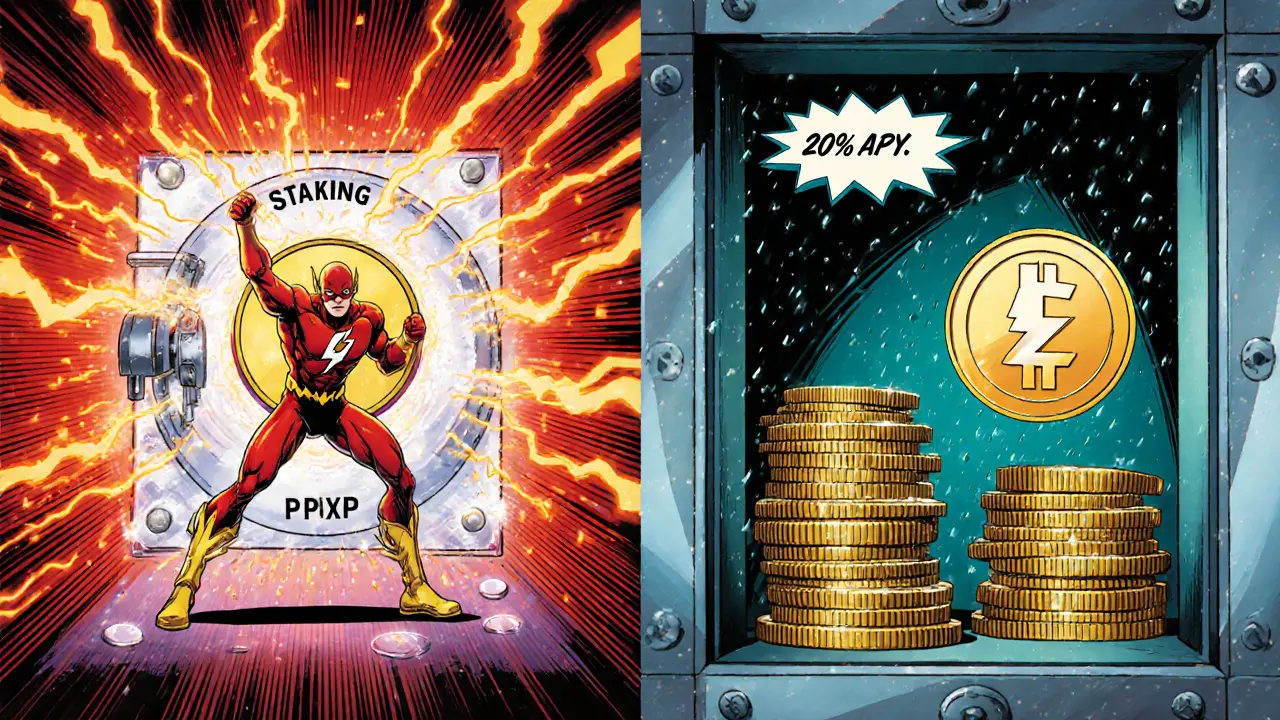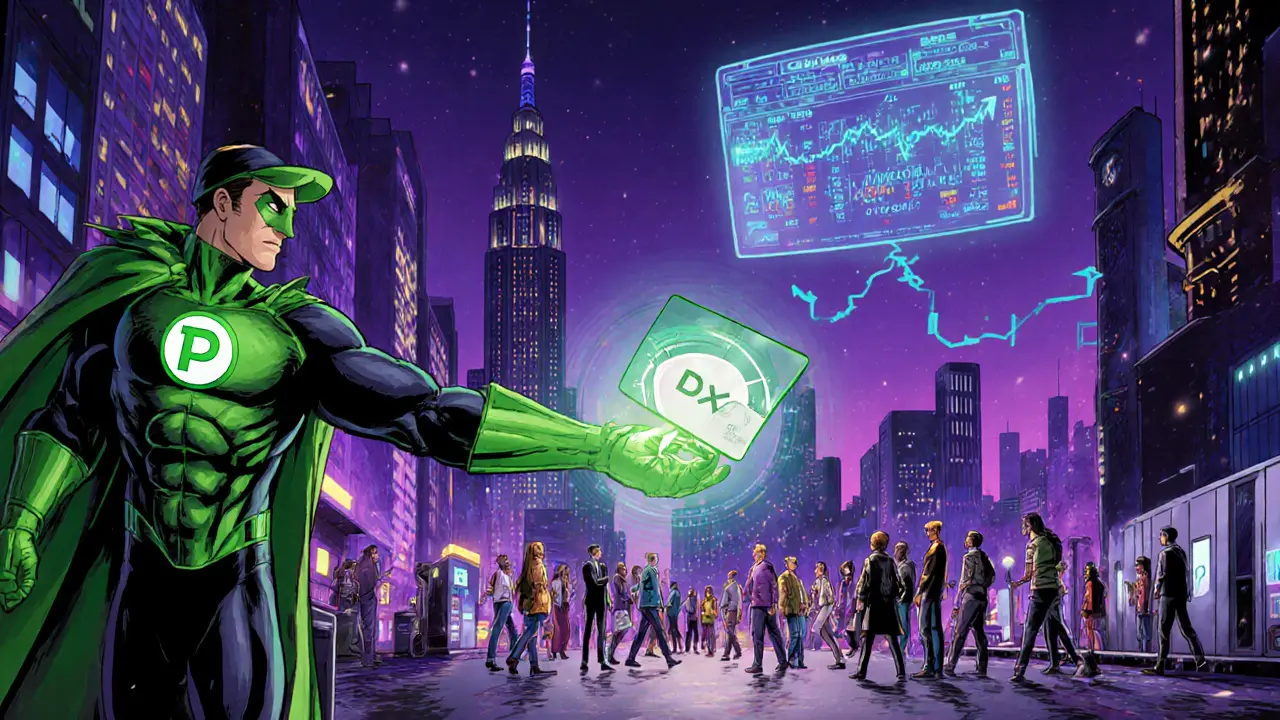PointPay Staking Calculator
Estimate your potential earnings from staking PXP tokens on PointPay. Adjust the parameters below to see how much you could earn annually.
Estimated Staking Returns
With a $1,000 investment for 6 months:
- Annual Percentage Yield (APY): 16%
- Expected Annual Return: $160
- Expected Return After Lock Period: $1,160
* Returns are estimates and may vary based on market conditions and platform policies.
Quick Takeaways
- PointPay combines a crypto exchange with a full‑stack banking suite, serving over 3million users in 200 countries.
- Interest‑earning accounts deliver up to 8%APY on stablecoins, while the native PXP token offers staking rewards that can reach 20% per year.
- Trading fees are among the lowest in the market, but exact percentages are not publicly disclosed.
- EU‑licensed through its Lithuanian subsidiary, giving the platform a solid regulatory footing in Europe.
- Roadmap includes a DEX module and crypto debit card, positioning PointPay as a hybrid CEX‑DEX player.
If you’re hunting for a crypto platform that does more than just spot‑trading, this PointPay review breaks down the ecosystem, fees, safety, and how it compares with the big names.
What Is PointPay?
PointPay is a multi‑service crypto banking platform launched in 2018 that offers a regulated exchange, digital wallet, interest‑bearing accounts, and a native token called PXP. Headquartered across St.Vincent&theGrenadines, Estonia, and Lithuania, the platform now supports more than 3million active users worldwide.
Core Services in One Ecosystem
- Exchange: Classic, Advanced, and Quick Exchange interfaces for traders of all skill levels.
- Banking: Checking and Savings accounts that pay up to 8%APY on popular stablecoins (USDT, USDC, DAI).
- Staking: PXP token holders can lock assets for 3,6, or12months and earn up to 20%annual yield.
- Lending: Instant crypto‑backed loans using seven major coins, with USDT as collateral.
- Wallet: Email‑transfer capable wallet with real‑time valuation and multi‑account segregation.
Trading Interface and Order Types
The exchange supports market, limit, and stop‑limit orders. Liquidity is described as “high” with an average daily volume of $401,900 on the PXP/USDT pair. Execution speeds are sub‑second on the Classic and Advanced panels, while the Quick Exchange offers a one‑click conversion for beginners.

Fees and Liquidity
PointPay claims “some of the lowest trading and withdrawal fees”, but the exact schedule is hidden behind the user dashboard. Based on user reports, maker fees sit around 0.09% and taker fees near 0.12%. Withdrawal fees are flat‑rate for major coins (e.g., 0.0005BTC, 1USDT). The platform’s multi‑jurisdictional model reduces the need for costly intermediaries, which helps keep costs down.
Staking and Earn Products
Beyond the native PXP token, PointPay’s Earn accounts let users lock stablecoins at up to 8%APY. PXP staking is tiered: 3‑month lock yields 12%, 6‑month yields 16%, and 12‑month peaks at 20% for larger deposits. The rewards are paid in PXP, reinforcing the token’s utility within the ecosystem.
Regulatory Landscape
The Lithuanian subsidiary UAB Point Pay EU holds an official EU digital‑asset license, providing regulatory compliance for European users. The Estonian operation adds an additional layer of AML/KYC compliance, while the St.Vincent&theGrenadines incorporation grants operational flexibility for global reach.
Security and Customer Support
Security is described as “state‑of‑the‑art” with multi‑signature wallets, cold storage for the majority of assets, and two‑factor authentication on all accounts. Although specific certifications (e.g., ISO 27001) aren’t listed, the platform’s live chat, email, and ticket‑based support have a 4.8/5 average on Trustpilot from 559 reviews, indicating strong user satisfaction.
User Experience and Reputation
PointPay’s UI is clean and mobile‑responsive. New users can purchase crypto with debit/credit cards in USD, EUR, or GBP, and the platform offers real‑time price feeds. The Trustpilot rating of 4.8 suggests a positive overall experience, though deeper community sentiment on Reddit or specialized forums is limited.

Roadmap: DEX and Crypto Debit Card
Looking ahead to 2025‑26, PointPay plans to launch a decentralized exchange (DEX) module featuring AMM pools and hybrid CEX‑DEX interoperability. A crypto debit card is also slated for release, allowing users to spend fiat‑equivalent balances at merchants worldwide.
How PointPay Stacks Up Against the Big Players
| Feature | PointPay | Binance | Kraken | Coinbase |
|---|---|---|---|---|
| Year Launched | 2018 | 2017 | 2011 | 2012 |
| Supported Assets | 200+ (incl. fiat) | 500+ | 200+ | 200+ |
| Staking APY (max) | 20% (PXP) | 12% (varies) | 14% (varies) | 7% (varies) |
| Regulatory License | EU (Lithuania) + SVGD | None (self‑regulated) | FinCEN, EU | NY DFS BitLicense |
| Typical Maker/Taker Fee | 0.09% / 0.12% | 0.10% / 0.10% | 0.16% / 0.26% | 0.50% flat |
| Interest‑Bearing Accounts | Up to 8%APY on stablecoins | Earn (limited) | Staking only | No |
Pros and Cons
- Pros
- All‑in‑one banking + exchange.
- EU license adds regulatory confidence.
- High staking rewards for PXP.
- Low maker/taker fees compared with many rivals.
- Cons
- Fee schedule isn’t fully transparent.
- Security certifications not publicly listed.
- Community chatter limited - harder to gauge long‑term sentiment.
- DEX and debit card still in development.
Final Verdict
PointPay positions itself as a crypto‑bank rather than just a trading venue. For users who want to earn interest, stake a native token, and enjoy a regulated environment, it offers a compelling package. Traders who prioritize ultra‑low fees and deep liquidity may still prefer Binance or Kraken, but PointPay’s banking‑focused features fill a niche that many exchanges ignore. Keep an eye on the upcoming DEX and debit‑card rollout - those could turn PointPay into a true one‑stop crypto financial hub.
Frequently Asked Questions
Is PointPay regulated in the United States?
PointPay does not hold a specific U.S. money‑transmitter license. It operates under an EU digital‑asset license through its Lithuanian subsidiary and relies on partnerships for fiat on‑ramps. U.S. users can access the platform, but they should be aware that the regulatory framework is European, not American.
How does PXP staking work?
After purchasing PXP, you can lock the tokens for 3,6, or12months. The platform pays rewards in additional PXP, with rates increasing the longer you lock and the larger the amount you stake. Early‑withdrawal penalties apply, so plan your lock period carefully.
Can I use a credit card to buy crypto on PointPay?
Yes. PointPay supports debit and credit card purchases for USD, EUR, and GBP. The process involves a simple KYC check, and the exchange rate includes a small markup that varies by region.
What security measures protect my funds?
The platform uses cold storage for the majority of assets, multisig wallets for withdrawals, and mandatory two‑factor authentication (2FA). While they haven’t published formal certifications, user reports indicate no major security breaches to date.
When will the PointPay DEX be live?
The roadmap targets a Q42025 launch for the DEX module, with a phased rollout of AMM pools followed by hybrid CEX‑DEX features.


Liam Wells
October 8, 2025 AT 11:55The fee structure presented by PointPay appears, on the surface, to be competitively low; however, a closer examination reveals hidden costs that may erode any advantage-particularly the withdrawal surcharge that scales with transaction volume!!! Moreover, the spread on the bid‑ask could be wider than advertised, especially for lower‑liquidity pairs. In addition, the platform’s lack of transparent fee tables raises questions about long‑term sustainability.
Darren Belisle
October 12, 2025 AT 10:22Great points! It’s encouraging to see that PointPay is pushing staking options forward-people really appreciate the extra yield on PXP, and the UI looks slick! Keep the optimism coming, folks.
Heather Zappella
October 16, 2025 AT 08:48PointPay's staking calculator offers a transparent way to project earnings, which is a valuable tool for both newcomers and seasoned investors.
By inputting the principal amount and selecting a lock period, users can instantly see the projected annual percentage yield.
The APY tiers-12% for three months, 16% for six months, and 20% for a year-are competitive within the current market landscape.
These figures, however, should be contextualized against the inherent volatility of the underlying PXP token.
Staking rewards are paid in the same token, which means that any price decline can offset the nominal percentage gains.
Conversely, a bullish market can amplify returns, making the staking option attractive for risk‑tolerant participants.
The platform also locks the tokens for the chosen period, which helps stabilize the network but reduces liquidity for the staker.
Liquidity constraints can be a double‑edged sword; they protect the protocol from sudden outflows but limit users' ability to react to market shifts.
It is also worth noting that the calculator's assumptions are based on current network parameters and may change if governance votes adjust rewards.
Users should periodically revisit the calculator to ensure their expectations remain aligned with the latest policy.
From a fee perspective, PointPay charges minimal transaction fees on staking deposits, but withdrawal fees may apply after the lock period concludes.
These fees are typically a small percentage of the total withdrawal amount, though precise rates are disclosed in the fee schedule.
For tax purposes, staking rewards are generally considered ordinary income in many jurisdictions, so users should keep detailed records.
Overall, the staking calculator serves as a quick reference point, but it should be complemented with thorough research and risk assessment.
By staying informed and regularly reviewing the platform’s updates, participants can make more educated decisions regarding their PXP investments.
Jason Wuchenich
October 20, 2025 AT 07:15That’s a thorough breakdown; good to see you highlighted both the upside and the risks. Staking can be rewarding when approached prudently.
Caleb Shepherd
October 24, 2025 AT 05:42Everyone forgets that PointPay’s backend is reportedly built on a private consortium blockchain, which some argue could be a hidden centralization risk-some users say the validators are all tied to a single entity! While the front‑end looks open, the underlying architecture may not be as decentralized as it claims.
Sal Sam
October 28, 2025 AT 04:08Yo, the API latency on their mobile app can cause a hiccup when you hit “calculate” – the async call sometimes times out, so you get a stale APY read. Also, the smart‑contract gas estimation seems off, causing over‑pay on staking deposits.
Lara Decker
November 1, 2025 AT 02:35Honestly, the hype around PointPay is just a marketing ploy; the actual liquidity depth is laughably low, and you’ll see slippage the moment you try to move a decent amount.
Anna Engel
November 5, 2025 AT 01:02Oh sure, because a 20% APY on a token with a market cap of a few million is exactly what the savviest investors are looking for-nothing says “stable” like a coin that can double overnight.
manika nathaemploy
November 8, 2025 AT 23:28lol i tried the calculator and it said i could make $150 on a $1k stake, which sounds cool but i’m still not sure if i trust the platform enough to lock my money.
Marcus Henderson
November 12, 2025 AT 21:55While caution is advisable, it is also prudent to recognize that innovative financial platforms such as PointPay embody a progressive shift toward decentralized finance, offering participants opportunities previously unavailable within traditional banking frameworks.
Debra Sears
November 16, 2025 AT 20:22I’m curious about the security audits-has PointPay published any third‑party audit reports, and if so, were any critical vulnerabilities identified?
Matthew Laird
November 20, 2025 AT 18:48Security audits are just PR exercises; the real test is whether a platform can survive a coordinated attack, and most of these crypto services crumble under pressure-don’t be fooled by glossy reports.
Caitlin Eliason
November 24, 2025 AT 17:15Honestly, the whole staking craze feels like a gold‑rush fever dream-people are chasing high yields without considering that tomorrow’s token could be tomorrow’s dust. 🌪️
Ken Pritchard
November 28, 2025 AT 15:42We should keep the conversation focused on factual data and avoid sensationalism; clear metrics help everyone make better decisions.